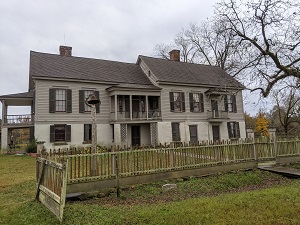Oxford Tree-Ring Laboratory - Georgia
Georgia

Hurt-Rives House, Hancock County, Georgia (33.308311, -83.120933)
Primary House Felling Dates: Spring 1803, Winter 1802/3
Site Master 1700-1802 (yellow pine) HRGAx1 (t = 7.11 GEORGIA1; 5.09 LLC; 5.02 BEGGx1).
Dendrochronological analysis has shown that the building was constructed from timbers felled in the winter of 1802/3 and the spring of 1803. .
History of the Hurt-Rives House, Hancock County, Georgia, by Mark Reinberger:
William Hurt (1756-1812) migrated to the backcountry of Georgia from Halifax County, North Carolina, though he had been born in Caroline County, Virginia, and his father, Joel (1726-1798), had originated in King William County and was later in Culpepper County, Virginia. Joel would eventually come to his son’s plantation and died there. Such peregrination was typical of the southern backcountry. The original grant of land (287 ½ acres on the waters of Shoulderbone Creek) that formed the basis for the Hurt-Rives Plantation was patented by John Bates in 1784, and it is believed that Bates sold the land to Hurt a year later.
It is unlikely that Hurt moved to Georgia before Hancock County was created out of Washington in 1793, as the frontier roiled with Indian troubles into the early 1790s. As late as 1787 Indians burned Greensborough, only 14 miles north of Hurt’s land, and this general area was particularly dangerous for settlers and saw Indian raids as late as 1793. Indeed, Shoulderbone Creek was a flashpoint for the Indians because of the treaty of that name which they had come to disavow. The first documents that record Hurt in Hancock County were tax records of 1794 and 1795, when he had 20 and 23 slaves respectively and 404 acres of land on Shoulderbone. It is believed that he brought that many enslaved people from North Carolina. He married in 1794 in Warren County, Georgia, where his wife lived and where he was taxed for another farm that year, perhaps a good indication of when he came to Georgia. However, his son, also William (1795-1848), was born in Halifax County, North Carolina, suggesting that he and his family hadn’t yet moved completely to Georgia.
William Hurt, the elder, built the first piece of the present house in 1803 (see dendrochronology above). Presumably he had a first log cabin, and perhaps a proper log house as well, before that. By 1820 the Hurts possessed 10 enslaved persons, though by that time William Hurt, the son, owned the land. He sold the much-expanded plantation in 1840 to George Rives (1771-1858) and moved to Alabama, thus continuing the family’s migratory tendencies. Rives altered the house by raising it on a full basement story and adding rooms and porches. The Rives family still owns the land and its many historic structures.
The house in its original form represents a fascinating migration of form from eastern North Carolina to the Georgia backcountry. Green Hill House, near Louisburg, Franklin County, North Carolina (built in the late eighteenth century by Major Green Hill) is nearly identical to the Hurt-Rives House in its original form and wood framed construction. It was also well known as the meeting place of the first Methodist Conference in America, in 1785. Franklin County is very close to Halifax County, where Hurt lived for many years, so Hurt would have known that type of house. In both houses the nearly square plan has three heated main rooms with a small unheated chamber adjacent to the largest room. The end with the largest room has a single chimney, but the other gable has two chimneys. Green Hill House is raised over a half basement. Hurt-Rives is now raised over a full basement which dates from changes after 1840, though its original foundation configuration is unknown. The original form of the Hurt-Rives House is also very similar to the framed George Gilmer House, originally in Oglethorpe County but now moved to Callaway Plantation in Wilkes County, built in 1801.
Worthington and Seiter 2024 "The Tree-Ring Dating of the Hurt-Rives House, Hancock County, Georgia." Oxford Tree-Ring Laboratory 2024/11
Oxford
Tree-Ring
Laboratory
The Oxford Tree-Ring Laboratory provides cutting-edge commercial dendrochronological services to homeowners, architectural historians, and cultural resource managers. READ MORE
Contact Information
Oxford Tree-Ring Laboratory
ProprietorsMichael Worthington
Jane Seiter, Ph.D
25 E. Montgomery St.
Baltimore, MD 21230
410-929-1520